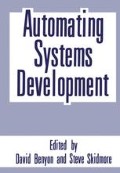Abstract
Current research within the Department of Computer Studies at Sheffield City Polytechnic indicates that it is possible to define a generalised database architecture which results in a worthwhile simplification of the traditional applications programming task. The approach adopted stems from the derivation, from normalisation procedures, of all the association relationships which exist between a set of entities, and then selecting the relevant subset of entities and association relationships for a specific application program. This subset is used to generate a data access schema, which has the important property that multiple data realisations can be performed on linked entities in anticipation of eventual demand. This reduces considerably the need for the programmer to specify explicit file handling operations within an application program. The data access schema is in fact one of four major structural software components in an application program which may be specified and generated. The other components are:-
-
1.
an information description schema, one per entity, which specifies record actions, data item transfers and global integrity rules,
-
2.
a process schema, which contains details of local integrity rules, that is, local to a specific application, and processing requests,
-
3.
a presentation object, which contains details of user presentation in terms of screens, reports and graphical output, as well as error handling and the overall sequencing of the applications task.
In DB4GL it is possible to specify the architectural features of these four software components through the use of special software tools, for example, a normalisation engine, or, a screen painter and also to define integrity rules and simple processing requirements. These specifications are used in the application generation process.
Access this chapter
Tax calculation will be finalised at checkout
Purchases are for personal use only
Preview
Unable to display preview. Download preview PDF.
References
“Database language SQL ” Draft International Standard IS0/DIS9075 available from British Standards Institution.
Batory D.S. “Modelling the Storage Architecture of Commercial Database Systems” ACM TODS Vol 10 (1985) pp 463–528.
Beeri C. and Kifer M. “An Integrated Approach to Logical Design of Relational Database Schemas” ACM TODS Vol II NO 2 (June 1986).
Bernstein P.A. “Synthesising Third Normal Form Relations from functional Dependencies” ACM TOPS Vol 1 No 1 (1976).
Blacklock P. “Standards for programming practices” Data Processing Vol 28 No 10 (Dec 1986).
Broy M. and Pepper P “Program Development as a Formal Activity” IEEE Transactions on software (Jan 1981).
Chamberlain D.D. et al “Sequel 2: A Unified Approach to Data Definition, Manipulation and Control” IBM Journal Research and Development Vol 20 No 6 (1976).
Chen P.P. “The Entity-Relationship Model - Toward a Unified View of Data” ACM TODS Vol 1 No 1 (1976).
Chen P.P. (ed.) “The Entity-Relationship approach to Systems Analysis and Design” North Holland (1980).
Chen P.P. (ed.) “The Entity-Relationship approach to Information Modelling and analysis” North Holland (1983).
Codd E.F. “A Relational Model of Data for Large Shared Data Banks” Communications of the ACM Vol 13 No 6 (June 1970).
Codd E.F. “Extending the database relational model to capture more meaning” ACM Transactions on database systems Vol 4 No 4 Dec (1979).
Codd E.F. “Relational Completeness of Data Base Sublanguages” Rustin R. (ed.) Data Base Systems Current Computing 6th Scientific Symposium Prentice-Hall Englewood Cliffs USA (1972).
Date C.J. “An Introduction to Database Systems - Volume II” Addison Wesley (1984).
Denoel E, Roelants D and Vauclair M. “Query translation for coupling PROLOG with a Relational data base management system” 3rd Esprit Conference (project 316) September (1986).
Earl A.N. and Whittington R.P. “Capturing the semantics of an IPSE database” Data Processing Vol 27 No 9 (Nov 1985).
Ewin N., Oxley R. and Poole F. “DB4GL:- A Fourth Generation System Prototyping Tool” Sheffield City Polytechnic Report Department of Building R/D/85/2 (1985).
Ewin N. “Advanced application software for speculative housing companies” M.Phil thesis (CNAA) Sheffield City Polytechnic (July 1985)
Fagin R. “Normal forms and relational database operators” Proc of the ACM SIGMOD (1979) ACM New York.
Hammer M. and McCleod D. “Database Description with SDM: A Semantic Database Model” ACM TODS Vol 6 No 3 (1981).
Longstaff J., Poole F., Roper J. “The Design of an Alternative Natural Language for Querying a Relational Database” Proc of ACM ICMOD (1978) MILAN
Maier D, Ullman J.D. and Moshe Y.V., “On the foundations of the Universal Relation Model” ACM TODS Vol 9 (1984) pp 283–308.
Mark L. and Roussopoulos N. “Metadata Management” IEEE Computer Vol 19 No 12 (Dec 1986).
Osborn S.L. and Heaven T.E. “The Design of a Relational Database System with Abstract Data Types for Domains” ACM TODS Vol II No 3 (Sept 1986).
Van Rigsbergen C.J. “A non-classical logic for information retrieval” The Computer Journal Vol 29 No 6 (1986).
Selinger P.G. et al “Access path selection in a relational database system” Proc ACM SIGMOD (1976) ACM New York pp 23–34.
Senko M.E. and Altman E.B. “DIAM II and levels of Abstraction The Physical Device Level: A General Model for Access Methods” Systems for Large Data Bases North Holland Publishing Company (1976).
Smith H.C. “Database Design: Composing fully Normalised Tables from a Rigorous Dependancy Diagram” CACM Vol 28 No 8 (1985).
Wiederhold G. “Views Objects and Databases” IEEE Computer Vol 19 No 12 (Dec 1986).
Wood M. (ed.) “Fourth Generation Systems” NCC Software Engineering Tools and Methods Issue 4 (Dec 1986).
Zloof M.M. “Query-by-Example: A Database Language” IBM Systems Journal Vol 16 No 4 (1977).
Author information
Authors and Affiliations
Editor information
Editors and Affiliations
Rights and permissions
Copyright information
© 1988 Plenum Press, New York
About this chapter
Cite this chapter
Poole, F. (1988). DB4GL - An Intelligent Database System. In: Benyon, D., Skidmore, S. (eds) Automating Systems Development. Springer, Boston, MA. https://doi.org/10.1007/978-1-4613-1033-4_6
Download citation
DOI: https://doi.org/10.1007/978-1-4613-1033-4_6
Publisher Name: Springer, Boston, MA
Print ISBN: 978-1-4612-8302-7
Online ISBN: 978-1-4613-1033-4
eBook Packages: Springer Book Archive

